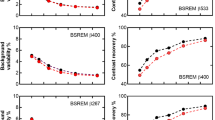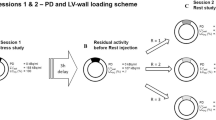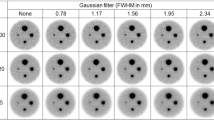Abstract
Background
Transmission (TX) scan time by use of radionuclide sources for cardiac positron emission tomography prolong imaging and increase the likelihood of patient motion artifacts. A reconstruction algorithm combining ordered-subsets expectation maximization with a Bayesian prior was developed and applied to rapid Germanium-68 (Ge-68) TX scans.
Methods and Results
A cardiac phantom with Fluorine-18 (Fl-18) was used to determine a minimal count threshold for Ge-68 TX scanning. Images were acquired over a count range from 2.5 ×106 to 8×107 and for a high-count scan of 1.6×109 counts to study reconstruction parameters and to determine the minimum TX count threshold. The method was compared against clinical 4-minute TX scans in ten Rubidium-82 (Rb-82) rest/stress myocardial perfusion studies (body mass index, 30±4kg/m2). The minimal count threshold was 20×106, and the mean scan time for the Rb-82 studies was 70.5±3.4 seconds. More than 90% of the segmental scores computed from images acquired via rapid TX scans differed by less than 5% from those obtained with 4-minute TX scans. The mean differences in perfusion scores between the rapid and 4-minute TX scans were 0.46% (95% confidence interval, −1.84% to 0.93%) at rest and 0.39% (95% confidence interval, −1.84% to 1.07%) at stress, demonstrating equivalency of the rapid and 4-minute scans.
Conclusions
Ordered-subsets expectation maximization with a Bayesian prior accurately and efficiently reconstructs rapidly acquired Ge-68 TX scans for Rb-82 myocardial perfusion positron emission tomography studies.
Similar content being viewed by others
References
Bailey DL. Transmission scanning in emission tomography. Eur J Nucl Med 1998;25:774–87.
Kinahan PE, Hasegawa BH, Beyer T. X-ray-based attenuation correction for positron emission tomography/computed tomography scanners. Semin Nucl Med 2003;33:166–79.
Bacharach SL, Bax JJ, Case JA, Delbeke D, Kurdziel KA, Martin WH, et al. PET myocardial glucose metabolism and perfusion imaging: part 1—guidelines for data acquisition and patient preparation. J Nucl Cardiol 2003;10:543–56.
Bateman TM, Cardiac positron emission tomography and the role of adenosine pharmacologic stress. Am J Cardiol 2004;94:19D-24D, discussion 24D–25D.
McCord ME, Bacharach SL, Bonow RO, Dilsizian V, Cuocolo A, Freedman N. Misalignment between PET transmission and emission scans: its effect on myocardial imaging. J. Nucl Med 1992; 33:1209–14, discussion 1214-5.
Bettinardi V, Gilardi MC, Lucignani G, Landoni C, Rizzo G, Striano G, et al. A procedure for patient repositioning and compensation for misalignment between transmission and emission data in PET heart studies. J Nucl Med 1993;34:137–42.
Loghin C, Sdringoia S, Gould KL. Common antifucis in PET myocardial perfusion images due to attentuation-emission misregistration: clinical significance, causes, and solutions. J Nucl Med 2004;45:1029–39.
Xu M, Cutler PD, Luk, WK, Adaptive, segmented attenuation correction for whole-body PET imaging. IEEE Trans Nucl Sci 1996;43:331–6.
Bettinardi V, Pagani E, Gilardi MC, Landoni C, Riddell C, Rizzo G, et al. An automatic classification technique for attenuation correction in positron emission tomography. Eur J Nucl Med 1999;26:447–58.
Zaidi H, Diaz-Gomez M, Boudraa A, Slosman DO. Fuzzy clustering-based segmented attenuation correction in whole-body PET imaging. Phys Med Biol 2002;47:1143–60.
Hudson HM, Larkin RS. Accelerated image reconstruction using ordered subsets of projection data. IEEE Trans Med Imaging 1994;13:601–9.
Lange K, Bahn M, Little R. A theoretical study of some maximum likelihood algorithms for emission and transmission tomography. IEEE Trans Med Imaging 1987;6:106–14.
Case JA, Pan TS, King MA, Luo DS, Penney BC, Rabin SZ. Reduction of truncation artifacts in fan be am transmission using a spatially varying gamma prior. IEEE Trans Nucl Sci 1995;42:2260–5.
Narayanan MV, Byrne CL, King MA. An interior point iterative maximum-likelihood reconstruction algorithm incorporating upper and lower bounds with application to SPECT transmission imaging. IEEE Trans Med Imaging 2001;20:342–53.
Case JA, Cullom SJ, Galt JR, Garcia EV, Bateman TM. Impact of transmission scan reconstruction using an iterative algorithm (BITGA) versus FBP: clinical appearance of attenuation-corrected myocardial perfusion SPECT images [abstract]. J Nucl Med 2001;42:51P.
Bateman TM, Cullom SJ. Attenuation correction single-photon emission computed tomography myocardial perfusion imaging. Semin Nucl Med 2005;35:37–51.
Case JA, Hsu BL, Bateman TM, Cullom SJ. A Bayesian iterative trunsmission gradient reconstruction algorithm for cardiac SPECT attenuation correction. J Nucl Cardiol 2007;14:324–33.
Hubbell JK, Seltzer SM. NISI National Institute of Standard and Technology. 1996, Available from: http://physics.nist.gov/PhysRefData/XrayMassCoef/ComTab/water.html
ECAT ACCEL High-Throughput Whoie Body PET Scanner Siemens. Medical Solutions Order No. A91004-M2330-G020-04-7600. PA 05035 2003.
Casey ME, Hoffman EJ. Quantification in positron emission computed tomography. A technique to reduce to reduce noise in accidental coincidence measurement and coincidence efficiency calibration. J Comput Assist Tomogr 1986;10:845–50.
Moisan C, Rogers JG, Douglas JL. A count rate model for PET and its application to an LSO HR PLUS scanner. IEEE Trans Nucl Sci 1997;44:1219–24.
Casey ME, Gadagkar H, Newport D. A component based method for normalization in volume PET. Int Mg Fully Three-Dim Img Recon Rad Nucl Med. P 67–71 Aix-les-Bains. France 1995.
Watson CC, Newport D, Casey ME, de Kemp RA, Beanlands RS. Schmand M. Evaluation of simulation-based scatter correction for 3-D PET cardiac imaging. IEEE Trans Nucl Sci 1997;44:90–7.
Bateman TM, Heller GV, McGhie AL, Friedman JD, Case JA, Bryngelson JR, et al. Diagnostic accuracy of rest/stress ECG-gated rubidium-82 myocardial perfusion PET comparison with ECG-gated Tc-99m-sestamibi SPECT. J Nucl Cardiol 2006;13: 24–33.
Kenney JF, Keeping ES. Standard error of the mean. Section 6.5. In: Mathematics of statistics, part 2. 2nd ed. Princeton (NJ): Van Nostrand: 1951. p. 110, 132–3.
Eisner RL, Streeter JT, Sigman MA, Stankewicz MA, Randolph PE. Critical role of counting statistics and segmented attenuation correction for transmission scans in PET Rb-82 attenuation: a cavetat for brief transmission scan [abstract]. J Nucl Med 2005;46:260–261P.
Author information
Authors and Affiliations
Corresponding author
Rights and permissions
About this article
Cite this article
Hsu, BL., Case, J.A., Moser, K.W. et al. Reconstruction of rapidly acquired Germanium-68 transmission scans for cardiac PET attenuation correction. J Nucl Cardiol 14, 706–714 (2007). https://doi.org/10.1016/j.nuclcard.2007.05.009
Received:
Accepted:
Issue Date:
DOI: https://doi.org/10.1016/j.nuclcard.2007.05.009




